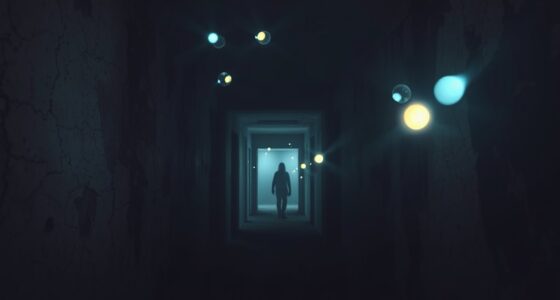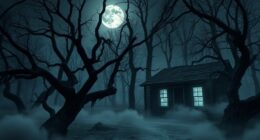There’s no scientific proof that ghosts can physically hurt you. Many fears stem from cultural stories, media, and psychological factors like stress or hallucinations. Common paranormal phenomena, such as shadows or noises, often have natural explanations like drafts or neurological effects. Understanding that these experiences lack evidence and are influenced by beliefs can help lessen your fears. If you want to learn more about separating fact from fiction, keep exploring the facts behind ghostly encounters.
Key Takeaways
- Scientific evidence does not support that ghosts can physically harm or interact with people.
- Most ghost sightings and sensations are caused by environmental, neurological, or psychological factors.
- Cultural beliefs and media influence fears, but these are not based on proven paranormal capabilities.
- Reports of injuries or harm linked to ghosts lack verifiable physical evidence or scientific validation.
- Understanding psychological and environmental causes helps separate fear from factual understanding of ghost-related phenomena.
The History of Ghost Sightings and Cultural Beliefs
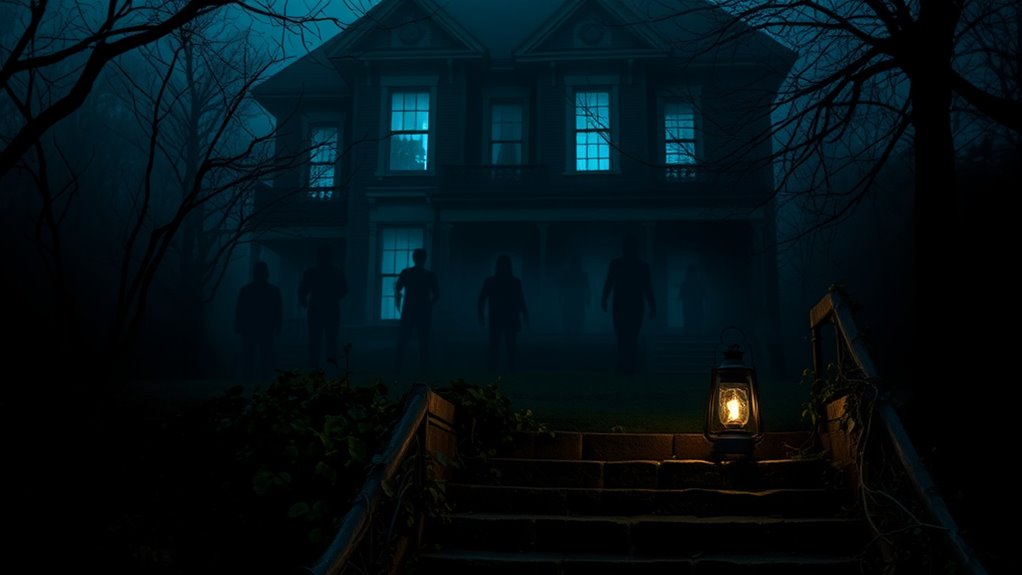
Throughout history, people across cultures have reported seeing ghosts, often interpreting these sightings as evidence of spirits or supernatural forces. Many cultures have documented historical hauntings, where specific locations or objects are believed to be haunted due to past events or tragedies. These stories have shaped cultural superstitions, influencing beliefs about spirits and the afterlife. For example, in Western traditions, ghost sightings often stem from unresolved issues or tragic deaths, while in other cultures, spirits are seen as protectors or messengers. These beliefs persist today, fueling fears and stories about haunted places. Understanding this historical context reveals how deeply rooted ghost sightings are in human history and cultural superstitions, shaping perceptions of the supernatural for generations. Additionally, Vetted – Grace for Life Designs offers insights into how these beliefs influence modern interpretations of paranormal phenomena. Recognizing the cultural significance of these stories helps us appreciate their enduring presence across societies. Moreover, research into historical hauntings demonstrates how collective memory and storytelling reinforce these beliefs over time, highlighting the importance of cultural narratives in shaping paranormal perceptions.
Common Paranormal Phenomena and Their Explanations
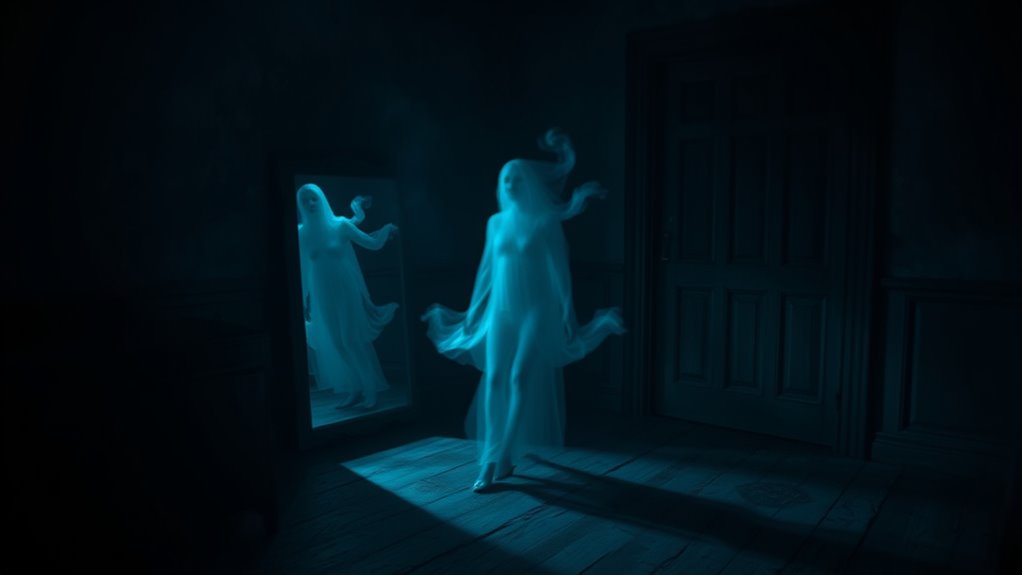
Many paranormal phenomena, such as ghostly apparitions, unexplained noises, and cold spots, are commonly reported in haunted locations. These experiences often feel real and unsettling, fueling fears of the supernatural. Many believe these phenomena are forms of paranormal communication, where spirits attempt to reach out. Ghostly apparitions may appear suddenly, sometimes seen as full-bodied figures or fleeting shadows. Unexplained noises like knocks or whispers can leave you feeling anxious, while cold spots create an eerie chill that seems to emanate from nowhere.
Ghostly apparitions, unexplained noises, and cold spots fuel fears of the supernatural.
- Feelings of being watched or touched by unseen hands
- Sudden drops in temperature that defy logic
- Unexplained voices calling your name
- Shadows that move just beyond your sight
While these experiences evoke strong emotions, they often have natural explanations, making it essential to differentiate fact from fiction. Additionally, some environmental factors, such as vetted indoor air circulation or electrical issues, can contribute to these phenomena, and understanding natural causes can help demystify these events. It’s also worth noting that home heating solutions, like heat pumps, can influence indoor air quality and temperature, potentially affecting perceptions of cold spots or strange sensations.
Environmental conditions, such as humidity levels and drafts, can also play a role in creating these perceived paranormal effects. Furthermore, many of these phenomena may be influenced by psychological factors, which can cause individuals to interpret ambiguous stimuli as paranormal.
Scientific Perspectives on Ghosts and Spirits
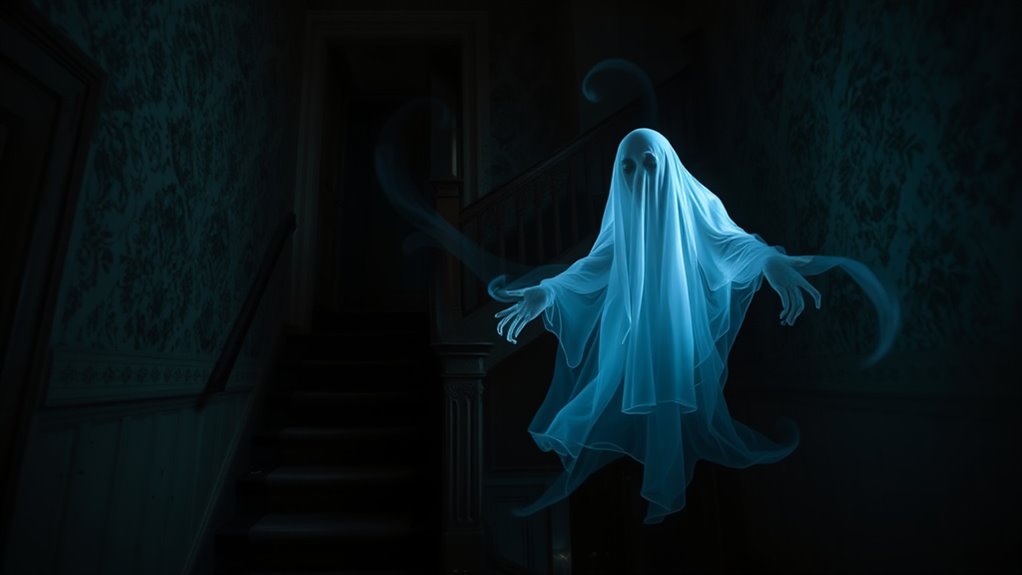
Scientific research offers alternative explanations for many phenomena traditionally attributed to ghosts and spirits. Quantum physics suggests that some experiences may result from energy fluctuations or particle interactions at a subatomic level, not supernatural entities. These energy interactions are often studied through particle interaction studies, which provide insight into how unseen forces might influence perceptual experiences. Biological theories propose that hallucinations, sleep paralysis, or neurological conditions cause these encounters. These explanations challenge the supernatural view, grounding the phenomena in scientific understanding. The table below summarizes key insights:
| Theory | Explanation | Evidence |
|---|---|---|
| Quantum physics | Energy fluctuations mimic ghostly appearances | Particle interaction studies |
| Biological theories | Brain chemistry causes hallucinations or paralysis | Neurological research |
| Cultural influences | Perceptions shaped by cultural expectations | Cross-cultural studies |
| Sensory deprivation | Altered senses lead to ghostly perceptions | Sleep studies |
| Environmental factors | EMF and toxins affecting brain function | Environmental research |
Additionally, understanding how consciousness interacts with physical phenomena may shed light on these experiences, suggesting they are rooted in the mind rather than the supernatural. Recent studies also indicate that neurological processes can produce vivid perceptual experiences similar to ghost sightings. Moreover, psychological factors such as stress and trauma can enhance susceptibility to these perceptions. Recognizing the scientific approaches used in these explanations can help differentiate between fear and factual understanding of the phenomena.
Psychological Factors That Influence Fear of the Unknown
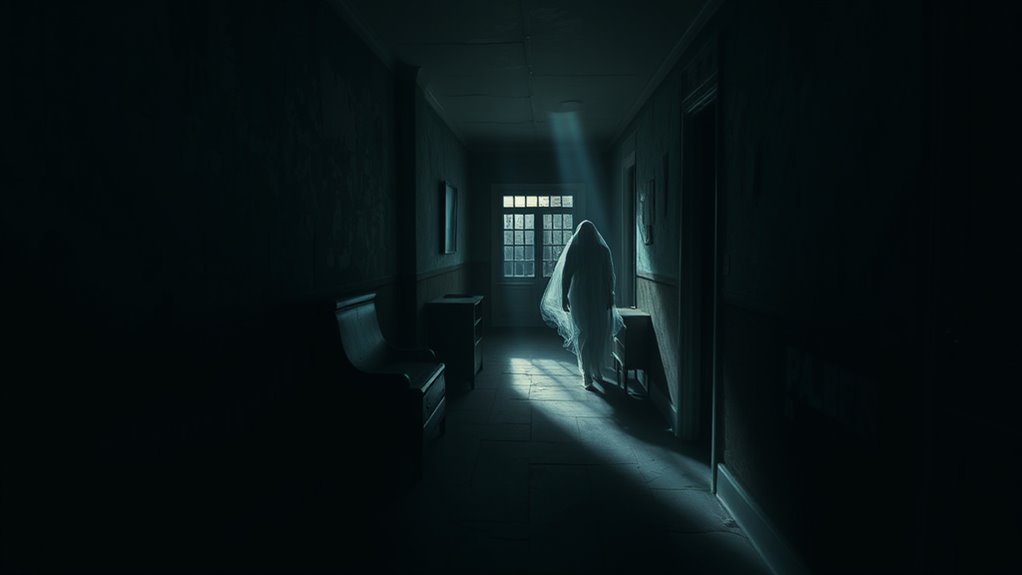
Fear of the unknown often stems from deep-seated psychological factors that shape how you perceive ambiguous or unfamiliar situations. Your mind can generate frightening images or sensations, especially during episodes like sleep paralysis, intensifying fears of ghosts or spirits. Cognitive biases, such as the tendency to interpret ambiguous cues as threatening, also play a big role. These biases make you more likely to see danger where none exists, fueling your fears. Additionally, understanding personal growth can help develop a more rational perspective by encouraging creative problem-solving and emotional expression.
How to Differentiate Between Fiction and Evidence-Based Claims

To effectively distinguish between fiction and evidence-based claims, you need to critically evaluate the sources and the quality of the information presented. Paranormal skepticism encourages you to question extraordinary stories and seek verifiable evidence. When *evaluating* claims, focus on evidence evaluation—look for scientific studies, credible witnesses, or physical proof rather than anecdotal accounts or sensationalized media. Be wary of claims that rely solely on emotional appeals or lack transparency about their methods. Reliable sources prioritize transparency, peer review, and reproducibility. By applying these principles, you can separate plausible explanations from imaginative fiction, helping you form a rational understanding of paranormal phenomena. This approach empowers you to make informed decisions rather than accepting sensational stories at face value.
Frequently Asked Questions
Are There Any Documented Cases of Physical Harm Caused by Ghosts?
There are very few documented cases of ghost attacks causing paranormal injuries. Most reports of physical harm attributed to ghosts lack solid evidence and are often anecdotal. While some believe ghosts can cause harm, scientific studies haven’t confirmed any real ghost attacks or paranormal injuries. You should approach such claims with skepticism, as they’re often based on fear rather than factual proof. Remember, separating fear from fact is key.
Can Ghost Encounters Have Long-Term Psychological Effects?
Imagine your mind as a delicate house of cards, easily shaken by ghost encounters. These experiences can lead to long-term psychological trauma, making you question reality. Memory distortion might cause you to recall events differently, fueling anxiety and paranoia. While ghosts can’t physically harm you, the mental scars they leave behind can be deep, emphasizing the importance of distinguishing between actual threats and your fears.
What Are the Most Credible Scientific Experiments Related to Ghosts?
When exploring if ghosts exist, you should look at credible scientific experiments rooted in paranormal research. While many studies aim to detect supernatural phenomena, scientific skepticism remains essential, emphasizing cautious interpretation of results. Experiments like those using electromagnetic fields or thermal imaging seek to find physical evidence of ghosts. Though intriguing, these studies often lack conclusive proof, so maintain a critical perspective while considering ongoing scientific efforts.
How Do Cultural Differences Influence Beliefs About Ghost Harm?
You might be surprised, but your belief about ghost harm often hinges on cultural rituals and belief systems. While some cultures see spirits as malevolent, others view them as protective. Ironically, these cultural differences shape your fears more than any actual threat. Your feelings about ghost harm are deeply rooted in societal norms, reinforcing the idea that what you fear is often more about perception than reality, not ghosts themselves.
Are There Specific Locations More Prone to Harmful Ghost Activity?
Certain haunted locations and geographic hotspots are believed to have higher ghost activity. You might notice more unexplained events or feelings of unease in places with a dark history or intense emotional energy. These areas often attract paranormal enthusiasts, and some say they’re more prone to harmful ghost activity. While science offers explanations, your experiences in these haunted locations can feel especially intense, fueling beliefs about dangerous spirits lurking there.
Conclusion
While it’s tempting to believe ghosts can harm you, history and science suggest otherwise. Many sightings and sensations often stem from psychological or environmental factors, not supernatural forces. Remember, coincidences—like feeling watched during a quiet moment—are easy to interpret as paranormal. By understanding the science and psychology behind these experiences, you can separate fact from fiction, realizing that fear often amplifies the unknown more than any ghostly presence ever could.




